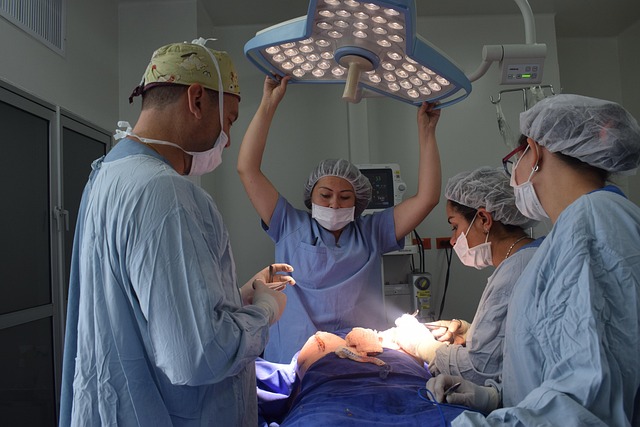Cosmetic surgery carries significant risks, requiring adequate liability coverage to protect surgeons and practices from financial losses due to medical malpractice claims. Comprehensive policies address patient harm, negligence in advice/treatment, excess liability for high judgments, and exclusions like consent issues. Staying current with standards, updating certifications, clear consent forms, and patient screening reduce legal exposure. Case studies highlight the need for robust coverage, protecting professionals from temporary disfigurement, adverse outcomes, and reputational damage. Navigating insurance options ensures financial protection against malpractice lawsuits and non-economic damages.
In the high-stakes world of aesthetic surgery, navigating liability risks is paramount. Cosmetic surgery liability coverage protects professionals from potential malpractice suits arising from procedures with inherent complexities and patient expectations. This comprehensive guide explores the multifaceted landscape of cosmetic surgery liability risks, essential insurance elements, common exclusions, and strategic minimization tactics. From real-world case studies to insurance navigation tips, discover how aesthetic professionals can safeguard their careers and practices.
- Understanding Cosmetic Surgery Liability Risks
- Essential Elements of Coverage for Surgeons
- Common Exclusions and Their Impact on Surgeons
- Strategies to Minimize Legal Exposure in Aesthetics
- Case Studies: Lessons from Real-World Scenarios
- Navigating Insurance Options for Aesthetic Professionals
Understanding Cosmetic Surgery Liability Risks

Understanding Cosmetic Surgery Liability Risks
Cosmetic surgery, while offering transformative benefits, comes with its share of risks and potential liabilities. Patients often seek aesthetic procedures to enhance their appearance or restore confidence, but outcomes are not always predictable. Medical complications can arise from surgeries, ranging from minor infections to severe reactions or even death in rare cases. These risks underscore the importance of adequate insurance coverage for aesthetic surgeons.
Cosmetic surgery liability coverage is crucial in protecting surgeons and their practices from financial losses due to medical malpractice claims. Such policies ensure that professionals are financially secured against potential lawsuits, enabling them to focus on patient care without undue worry. Effective coverage involves understanding policy limits, exclusions, and specific needs, ensuring comprehensive protection for the unique challenges presented by cosmetic procedures.
Essential Elements of Coverage for Surgeons

For aesthetic surgeons, comprehensive cosmetic surgery liability coverage is paramount. This insurance protects against potential risks and lawsuits arising from procedures like breast augmentations, facelifts, and rhinoplasties. Key elements of effective coverage include malpractice liability, which compensates for harm caused to patients during or after surgeries; professional liability, addressing claims of negligence related to the surgeon’s advice, diagnosis, or treatment plans; and excess liability or umbrella coverage, providing an additional layer of protection against significant judgments or settlements that exceed the primary policy limits.
Additionally, surgeons should consider coverage for medical malpractice lawsuits, which can arise from miscommunication, errors in surgery, or failure to obtain informed consent. Adequate cosmetic surgery liability coverage not only safeguards surgeons’ financial well-being but also instills confidence in patients, assuring them that their procedures are managed with the utmost care and foresight.
Common Exclusions and Their Impact on Surgeons

Many insurance policies for aesthetic surgeons include common exclusions that can significantly impact their protection. These exclusions often relate to consent, known risks, and the type of procedures performed. For instance, if a surgeon fails to obtain informed consent from a patient or provides information that omits key risks associated with a procedure, this could lead to legal liability. Moreover, certain high-risk cosmetic surgeries may not be covered under standard policies, leaving surgeons vulnerable if something goes wrong.
The impact of these exclusions is profound, as aesthetic surgeons must balance providing quality care with managing potential legal and financial risks. Adequate cosmetic surgery liability coverage is essential to shield practitioners from substantial claims and settlements, ensuring they can continue delivering specialized care without undue concern.
Strategies to Minimize Legal Exposure in Aesthetics

Minimizing legal exposure is a critical aspect of practicing aesthetic medicine, given the high-stakes nature of cosmetic procedures. Aesthetic surgeons can employ several strategies to bolster their defense and protect against potential claims. First, staying abreast of the latest medical standards and best practices is paramount. Adhering to these guidelines not only enhances patient safety but also serves as a robust defense mechanism in case of litigation. Regular training and certification updates ensure practitioners remain competent and knowledgeable about industry advancements.
Additionally, establishing clear consent forms and comprehensive patient screening processes can significantly reduce risks. Informed consent ensures patients understand the procedures’ potential outcomes, risks, and alternatives, safeguarding practitioners from claims of negligence. Thorough pre-operative evaluations identify patients who may be unsuited for certain procedures, minimizing complications and potential legal repercussions.
Case Studies: Lessons from Real-World Scenarios

Case studies play a crucial role in understanding the real-world implications of cosmetic surgery liability coverage. By examining actual scenarios, we can glean valuable lessons that highlight both potential risks and successful mitigation strategies. For instance, consider a case where a highly regarded aesthetic surgeon performed a popular facial rejuvenation procedure on a young patient. Despite the surgeon’s expertise, complications arose due to an unexpected reaction to the anesthesia, leading to temporary disfigurement. This incident underscored the importance of comprehensive liability coverage that extended beyond standard malpractice insurance. The surgeon, lucky to be insured, was able to navigate the legal fallout and ultimately resolved the case amicably, ensuring patient satisfaction while preserving their reputation.
This scenario demonstrates that even the most skilled professionals are not immune to risks. Adequate cosmetic surgery liability coverage should account for these rare but significant events, providing financial protection against potential lawsuits and settlements. By learning from such real-world instances, other aesthetic surgeons can proactively assess their insurance needs, stay compliant with industry standards, and minimize exposure to financial and reputational damage.
Navigating Insurance Options for Aesthetic Professionals

Navigating insurance options is a crucial aspect of running a successful aesthetic practice. Cosmetic surgery liability coverage protects professionals from potential financial burdens arising from medical malpractice lawsuits. These suits can result from adverse outcomes, complications, or dissatisfaction with procedures, leading to significant legal and monetary liabilities.
Aesthetic surgeons should carefully consider their insurance needs, evaluating policy limitations, exclusions, and the scope of protection offered. Comprehensive cosmetic surgery liability coverage includes not only medical expenses but also legal fees, settlement costs, and non-economic damages. Choosing the right insurance plan involves assessing risk factors specific to various procedures, understanding industry standards, and staying updated on regulatory changes that may impact liability protections.
